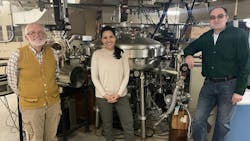Purdue PFAS Test Detects ‘Forever Chemicals’ in Hours
Purdue University researchers have created a new testing method to detect per- and polyfluoroalkyl substances, or PFAS, and speed the discovery of alternative substances.
The team produced 915 new PFAS-like molecules from more than 1,000 reactions in a few hours with a 90% success rate, according to a Nov. 12 news release.
The researchers employed a process called high-throughput electrospray ionization mass spectrometry, or HT DESI-MS. In HT DESI-MS, tiny droplets trigger rapid chemical reactions that can be analyzed in seconds.
The university describes DESI-MS as a 20-year-old technology that employs “a charged solvent spray to impact on a surface, generating a thin film in which a microextraction event occurs, followed by the generation of splashed secondary microdroplets that carry the desorbed analytes to a mass spectrometer.”
The contactless nature of the technology allows for direct analysis of complex mixtures that are typically not compatible with mass spectrometry, such as non-liquid samples.
“Our new method employs a multiuser platform developed at Purdue that is accessible to any researcher to detect, chemically modify or evaluate how these chemicals impact biological systems,” said research lead Christina Ferreira. “The Purdue method also opens a door into making tools that chemically transform PFAS and break them down.”
The research team published their findings in the peer-reviewed journal Environmental Science & Technology Letters.
The researchers disclosed their methods to the Purdue Innovates Office of Technology Commercialization, which has applied for a patent from the U.S. Patent and Trademark Office to protect the intellectual property.
About the Author
Jonathan Katz
Executive Editor
Jonathan Katz, executive editor, brings nearly two decades of experience as a B2B journalist to Chemical Processing magazine. He has expertise on a wide range of industrial topics. Jon previously served as the managing editor for IndustryWeek magazine and, most recently, as a freelance writer specializing in content marketing for the manufacturing sector.
His knowledge areas include industrial safety, environmental compliance/sustainability, lean manufacturing/continuous improvement, Industry 4.0/automation and many other topics of interest to the Chemical Processing audience.
When he’s not working, Jon enjoys fishing, hiking and music, including a small but growing vinyl collection.
Jon resides in the Cleveland, Ohio, area.

